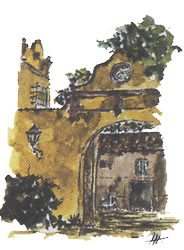Clostridium botulinum - Botulism: General information.
Characteristics of Clostridium botulinum and botulinum toxin/s
Clostridium botulinum is an strict anaerobic grampositive bacillus, genus Clostridium, family Clostridiaceae, spore-forming, that produces a neurotoxic toxin. This bacterium is usually found in soil and untreated fresh water and sediments (oceans, lakes), with a worldwide distribution. In some circumstances this organism can contaminate food and grow in them to produce their toxin/s. Botulism, a serious form of food poisoning, results from ingestion of food containing the toxin. Although this disease is rare, their mortality rate is high. When the toxin type was determined among 1036 cases detected in US between 1899 and 1990, 384 were for A toxin, 106 due to B toxin, 105 to E toxin and 3 to F toxin. Sometimes may be cases due to two toxins, for example A and B.
All forms of human or animal botulism, are caused by absorption of botulinum toxin formed during the multiplication of the bacterium Clostridium botulinum. The toxin has a toxicity (neurotoxicity) very high, so that exerts its action at extremely low levels, is thermolabile, while spores of the bacteria are heat resistant and survive in foods heated to over 100ºC, such as canned under thermal treatment. Besides, some strains of C. botulinum, C. butyricum, C. baratii and C. argentinense can produce botulinum neurotoxins.
There are seven toxin types (A - G) differentiable by neutralization tests, useful for clinical and epidemiology. Types A, B, E and F are the main causes of human botulism, while types C and D are found in cases of animal botulism, the most affected being wild birds and poultry, cattle, horses and some species of fishes. Types A and B are the most common in men, and are mainly related to contamination of home-prepared canned vegetables, but in Europe these types have also been found in relation to meat products. The E-type (fish) found in aquatic environments and correlates with E botulism cases concerning contaminated fish or shellfish, and is increasing. The F type is exceptional. Type C is subdivided into C1 (neurotoxin) and C2 (not neurotoxin affects vascular permeability and enterotoxigenic). The G type is produced by C. argentiniense (isolated from ground in Argentina, serum of deceased patients, although it is unclear involvement).
Toxins are synthesized during the growth of the bacterium as an inactive protein (150 kDa), which is released from the bacteria during lysis. To activate the toxin formed should degrade into two polypeptide chains (50 and 100 kDa).
C. botulinum, can differentiate into groups according to their culture characteristics, biochemical and physiological. All cultures type A and some of the type B and F are proteolytic. Cultures of C. botulinum toxins produced by C and D are not proteolytic, when cultured in a medium with coagulated egg white or flesh. All types E and some of the type B and F are non-proteolytic, but have characteristics of carbohydrate metabolism that differ from non-proteolitics groups types C and D. The strains of type G not have It has been studied in sufficient detail for effective and satisfactory characterization.
The optimum temperature for growth and toxin production is about 35ºC for the proteolytic strains; for non-proteolytic strains is 26-28ºC. Non-proteolytic types B, E and F strains can produce toxin at refrigeration temperatures (3-4ºC). Toxins of non-proteolytic strains do not show maximum toxicity until activated toxin with trypsin. Toxins from proteolytic strains are generally produced in its activated form.



